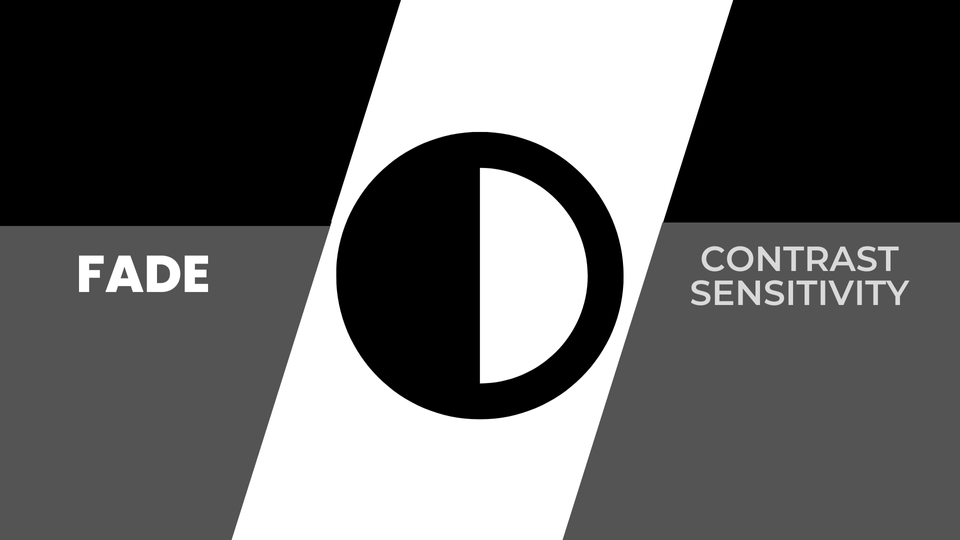
Fade

CONTRAST SENSITIVITY
is the ability of the visual system to distinguish objects from their background, especially when they do not stand out clearly. It measures the minimum contrast a viewer needs to detect a pattern, object, or detail. Unlike visual acuity, which assesses how well one can see fine detail (often described as "sharpness" of vision), contrast sensitivity is about how faint these details can be and still be perceptible.
FADE- measures contrast sensitivity, or your ability to distinguish objects as their brightness or darkness becomes similar to their surroundings.
FADE: CONTRAST SENSITIVITY
Select one of the multiple-choice options to match what you see displayed above.
Click 'I can't distinguish any letters' if you cannot proceed.
A low display brightness will negatively affect your performance. If you use a laptop or tablet, check your brightness settings before proceeding.
Press ESC to bring up the options menu anytime
The practice does not pause.
The concept is rooted in that real-world objects vary in size and contrast against backgrounds. For example, a dark object against a bright sky has high contrast, while light fog over a landscape creates low-contrast scenes.


Contrast sensitivity is often represented by a contrast sensitivity function (CSF), a chart showing how sensitivity changes with spatial frequency (the size or frequency of an object's details). This function characterizes how well an individual can detect sine-wave gratings, patterns of alternating dark and light bars at different frequencies and contrast levels.
Factors that can affect contrast sensitivity include:
- Illumination: Low light can reduce contrast sensitivity.
- Glare: Bright light can scatter within the eye, reducing contrast.
- Refractive Error: Uncorrected or improperly corrected vision can impact contrast perception.
- Age: Contrast sensitivity generally decreases with age.
- Ocular Diseases: Conditions such as cataracts, glaucoma, and macular degeneration can significantly affect contrast sensitivity.
- Neurological Conditions: Diseases affecting the optic nerve or the brain can also impact contrast sensitivity.
Contrast sensitivity testing is essential in many contexts, such as:
- Vision Testing: To better understand a person's vision, especially in glare or fog.
- Eye Disease Diagnosis: Some diseases preferentially affect contrast sensitivity.
- Designing Visual Displays: Ensuring information is accessible to those with reduced contrast sensitivity.
- Driver's Licensing: Certain jurisdictions test contrast sensitivity for driving licenses.
Tests for contrast sensitivity often involve charts or specialized equipment that present patterns or images with varying levels of contrast and ask the subject to identify or respond to the patterns.
On the performance side, imagine picking up a white baseball against a cloudy sky. Fade measures how well you can see something when it doesn't stand out much from the background. This is important for picking up the spin on the ball as it comes towards you, especially in low-light conditions.
Contrast sensitivity is a crucial visual ability in sports. It allows athletes to quickly and accurately detect and respond to differences in brightness, patterns, and textures within their visual field. This skill is essential for tracking moving objects, distinguishing teammates from opponents, and making split-second decisions based on visual cues.
Here are several examples from different sports illustrating the importance of contrast sensitivity:
Soccer:
- Detect the ball's movement against the field's background, especially in low-contrast situations like shadows or glare.
- Distinguish between teammates' and opponents' uniforms to make accurate passes and avoid turnovers.
Tennis:
- Tracking the tennis ball against the court surface and background, mainly when serving or returning fast-paced shots.
- Anticipate the ball's spin and trajectory based on subtle visual cues from the opponent's racket and body movements.
Basketball:
- Identify teammates in peripheral vision and make quick, accurate passes in fast-paced gameplay.
- Detect subtle changes in the texture of the ball's surface to maintain proper grip and control during dribbling and shooting.
Ice Hockey:
- Tracking the puck against the white background of the ice, especially when it is moving at high speeds or partially obscured by other players.
- In quick, dynamic gameplay situations, distinguish between teammates' and opponents' jerseys.
Motor Sports & F1:
- Detecting changes in the road surface, such as variations in color or texture, to - anticipate grip levels and adjust driving technique accordingly.
- Identifying and responding to visual cues from other vehicles, such as brake lights or sudden movements, to avoid collisions and maintain optimal racing lines.
Skiing and Snowboarding:
- Distinguish between snow textures and contours to maintain balance and control, especially in flat light or whiteout conditions.
- Identifying and avoiding obstacles like rocks, trees, or other skiers/snowboarders against a predominantly white background.
In all these examples, athletes with better contrast sensitivity have an advantage in quickly processing and responding to relevant visual information. This allows them to make more accurate decisions, react faster, and perform better in their respective sports.

